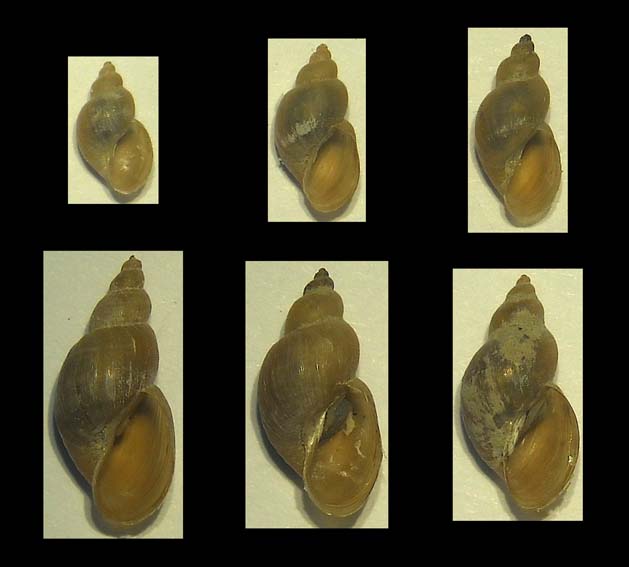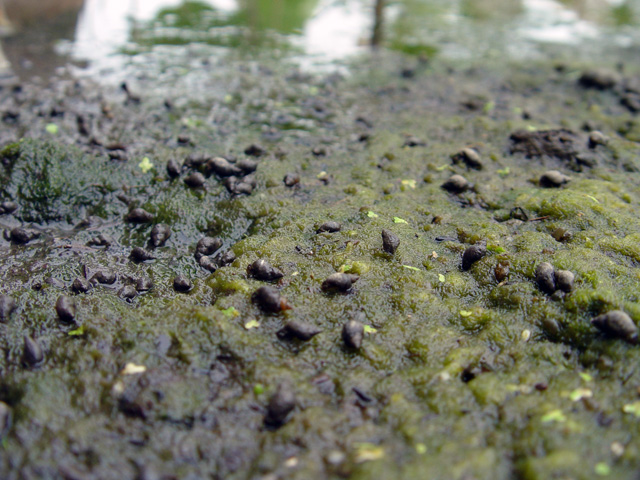Fossaria or Galba humilis, obrussa, modicella, parva, etc.
> Habitat & Distribution
Lymnaea humilis ranges throughout North America, from Alaska to Florida (Baker 1911, Clarke 1981, Jokinen 1992, Thompson 1999). Populations are typically semiaquatic, inhabiting muddy areas at or above the water line near streams, lakes, ponds, and marshes (Clarke 1981, Stewart and Dillon 2004). Lymnaea humilis can inhabit oligotrophic, mesotrophic, or eutrophic water bodies (Clarke 1979) and is an excellent colonizer of new habitats, quickly invading young ponds devoid of vegetation and other species of gastropods (Jokinen 2005).
Populations of L. humilis are widespread throughout drainages of The Great Plains, The Ohio, The Tennessee/Cumberland, and the Middle Atlantic states, becoming less common in the southeast. For quite a few years we were unable to locate any populations in South Carolina whatsoever, especially puzzling in view of the fact that the type locality of L. humilis was given as "South Carolina" by Say (1822). See my essay of 25June08 (link below) for further discussion. More recently we have discovered scattered populations along the Wateree and Congaree Rivers in Kershaw and Richland Counties. We also have one record from Georgia, by the Yellow River at Porterdale. FWGNA incidence rank I-5.
> Ecology & Life History
Although L. humilis can thrive in waters with low levels of dissolved oxygen, populations in Manitoba disappeared from several sites affected by intensive agriculture and logging (Pip 2000). Flooding from hydro dams has also caused local extinctions of semiaquatic L. humilis populations in Manitoba.
Like other pulmonate snails, L. humilis is monecious and almost certainly capable of self-fertilization as well as outcrossing (Dillon 2000). Populations of the (closely related) L. truncatula of Europe seem to reproduce primarily by selfing (Trouve' et al. 2003). Studies of population size frequency distribution have suggested an annual life cycle for L. humilis (Type A of Dillon 2000: 156 - 162), with a maximum lifespan of 16 months (McKillop 1985, Jokinen 1992). Brown (2001) suggested that L. humilis may lay eggs continuously throughout the summer.
Dillon s (2000: 360-363) USR reanalysis of Jokinen s Connecticut data suggested that L. humilis populations (listed as Fossaria modicella Say, 1825) seem to be Undifferentiated with respect to life history adaptation.
Lymnaea humilis is one of several smaller-bodied, amphibious ( fossarine ) lymnaeid taxa capable of serving as an intermediate host for trematodes causing fascioliasis in livestock, and rarely humans (Bargues et al. 2007). This has attracted significant parasitological interest in the entire worldwide subgenus (or genus) Galba. For reviews of the large literature, see Mas-Coma and colleagues (2005, 2009). Loker and colleagues (2021) have contributed an excellent study of parasitim in a population of L. humilis from the western United States, featuring a lovely figure to illustrate shell morphological variation across North America.
> Taxonomy & Systematics
The taxonomy of L. humilis has become elaborately entangled with that of L. cubensis, a similarly small, amphibious species more southern in its distribution. Baker (1911) was the first to distinguish the two species by the number of cusps on their first marginal tooth, humilis with three and cubensis with two. It seems likely, however, that the specimens in Thomas Say s hand when he described humilis in 1822 were not tricuspid, but rather from a bicuspid population collected near Charleston, South Carolina. For that reason, we recommend that the type locality for L. humilis be restricted to the Susquehanna River at Owego, NY, where populations are entirely tricuspid. See my essay of 25June08 from the link below.
Baker s original (1911) classification of the Lymnaeidae assigned humilis (together with at least 60 80 other specific nomina) to a large, inclusive genus Galba (Schrank 1803), which he later (1928) subdivided and emended to Fossaria (Westerlund 1885). Burch (1989) followed Baker (1928), gathering humilis together with ten other nominal species and subspecies of small, tricuspid lymnaeids into the subgenus Fossaria (ss). Meanwhile, European consensus has continued to favor Galba.
Quite a few molecular phylogenies have been published in recent years involving L. humilis, L. cubensis, and a variety of other lymnaeid taxa worldwide (e.g., Bargues & Mas-Coma 1997, Remigio 2002, Correa et al. 2010, 2011). See my post to the FWGNA blog of 4June12 from the link below for a critical examination of this literature. It continues to be our impression that the simple classification system of Hubendick (1951) fits the available data best. See my essay of 28Dec06 available from the link below for more.
More recently, large-scale surveys of morphological divergence, multiplex PCR genotype, and DNA sequence variation have thrown significantly more light on evolutionary relationships in the worldwide genus Galba (Alda et al. 2018, 2021). Results confirm Hubendick s hypothesis that all ten of the nominal species listed by Burch (1989) in the subgenus Fossaria (s.s.) are conspecific, except the (trans-Beringian) L. truncatula. Among the many junior synonyms of L. humilis are cyclostoma, exigua, galbana, modicella, obrussa, parva, peninsulae, rustica, and tazewelliana. For more, see my essay of 6July21 from the link below.
> Maps and Supplementary Resources
- Lymnaea distribution in drainages of The Ohio (2019)
- Lymnaea humilis distribution in Atlantic drainages (2023)
- Lymnaea distribution in Georgia and the Florida panhandle (2025)
- Lymnaea distribution in the Tennessee/Cumberland (2022)
- Distribution of Lymnaea (Galba) in The Great Plains (2024)
- Shell variation in L. humilis from its type locality at Owego, New York.

- Lymnaea humilis grazing on a stem, courtesy of Ms. Lori Schroeder and Mr. Bill Frank.
- Blackbeard's L. humilis, courtesy of Aydin Orstan.
> Essays
- See my post to the FWGNA blog of 28Dec06 for a review of The Classification of the Lymnaeidae.
- I reviewed the taxonomic histories of L. humilis and L. cubensis in my post of 25June08, entitled The Type Locality of Lymnaea humilis. I have also made available photos comparing the radulae of these two very similar species.
- See my essay of 4June12 for a review of the large molecular phylogenetic literature that had accumulated on the Lymnaeidae as of that date, The Lymnaeidae 2012: Stagnalis yardstick.
- I revisited the systematics and taxonomy of L. humilis and related taxa worldwide in my blog post of 7Aug12, The Lymnaeidae 2012: Fossarine football.
- I reviewed the entire worldwide fauna of crappy-little amphibious lymnaeids in 7June21, The American Galba and The French Connection. That post featured a couple nice comparative figures of shell and radula.
- Reproductive mode was the focus of my essay of 22June21, The American Galba: Sex, Wrecks, and multiplex. That post reviewed the new multiplex PCR test we developed to distinguish G. cubensis, G. truncatula, and G. schirazensis. No direct evidence on L. humilis, however.
- In my post of 6July21 I reviewed the results of the big international research effort of Alda and colleagues (2021), Exactly 3ish American Galba. There the synonymy of all nominal species of tricuspid North American fossarines was amply justified.
> References
Alda, Pilar, M. Lounnas, A.V zquez, R. Ayaqui, M. Calvopi a, M. Celi-Erazo, R.T. Dillon Jr., L. Gonz lez Ram rez, E. Loker, J. Muzzio-Aroca, A. N rvaez, O. Noya, A. Pereira, L. Robles, R. Rodr guez-Hidalgo, N. Uribe, P. David, P. Jarne, J-P. Pointier, & S. Hurtrez-Boussès (2021) Systematics and geographical distribution of Galba species, a group of cryptic and world-wide freshwater snails. Molecular Phylogenetics and Evolution 157: 107035. [pdf] [html]
Alda, Pilar, M. Lounnas, A. V zquez, R. Ayaqui, M. Calvopi a, M. Celi-Erazo, R. T. Dillon, Jr., P. Jarne, E. Loker, F. Pareja, J. Muzzio-Aroca, A. N rvaez, O. Noya, L. Robles, R. Rodr guez-Hidalgo, N. Uribe, P. David, J-P. Pointier, & S. Hurtrez-Bouss s (2018). A new multiplex PCR assay to distinguish among three cryptic Galba species, intermediate hosts of Fasciola hepatica. Veterinary Parasitology 251: 101-105. [pdf] [html]
Baker, F. C. 1911. The Lymnaeidae of North and Middle America, Recent and Fossil. Special Publication, no. 3. Chicago: Chicago Academy of Natural Sciences. 539 pp, 55 pl.
Baker, F. C. 1928. Freshwater Mollusca of Wisconsin, Part I, Gastropoda. Bull. Wisc. Geol. Natur. Hist. Survey, no. 70. Madison: University of Wisconsin Press.
Bargues, M.D., and S. Mas-Coma (1997) Phylogenetic analysis of lymnaeid snails based on 18S rDNA sequences. Mol. Bio. Evol. 14: 569 577.
Brown, K.M. 1982. Resource overlap and competition in pond snails: an experimental analysis. Ecology 63:412-422.
Brown, K.M. 2001. Mollusca: Gastropoda. In: J.H. Thorp and A.P. Covich, eds., Ecology and Classification of North American Freshwater Invertebrates, Academic Press, New York. Pp. 297-329.
Burch, J. B. 1989. North American Freshwater Snails. Malacological Publications, Hamburg, MI. 365 pp.
Burgarella, C. et al. (2015) Molecular evolution of freshwater snails with contrasting mating systems. Mol. Biol. Evol. 32(9): 2403 - 2416.
Clarke, A.H. 1979. Gastropods as indicators of trophic lake stages. Nautilus 93:138-142.
Clarke, A.H. 1981. The Freshwater Molluscs of Canada. National Museum of Natural Sciences, National Museums of Canada, Ottawa, Canada.
Correa, A. C., J. S. Escobar, P. Durand, F. Renaud, P. David, P. Jarne, J-P Pointier, & S. Hurtrez-Bousses. 2010. Bridging gaps in the molecular phylogeny of the Lymnaeidae (Gastropoda: Pulmonata), vectors of Fascioliasis. BMC Evolutionary Biology 10: 381.
Correa, A. C., J. S. Escobar, O. Noya, L. E. Velasquez, C. Gonzalez-Ramirez, S. Hurtrez-Bousses, and J. P. Pointier. 2011. Morphological and molecular characterization of Neotropic Lymnaeidae (Gastropoda: Lymnaeoidea), vectors of fasciolosis. Infection, Genetics and Evolution 11: 1978-1988.
Dillon, R.T., Jr. 2000. The Ecology of Freshwater Molluscs. Cambridge University Press, Cambridge, United Kingdom.
Hoff, C. C. 1936. Studies on the lymnaeid snail, Fossaria parva (Lea). Part I. Winter habits. Trans. Illinois Acad. Sci. 29: 29: 259 - 262.
Hoff, C. C. 1936. Studies on the lymnaeid snail, Fossaria parva (Lea). Part II. Seasonal life history. Trans. Illinois Acad. Sci. 30: 303 - 306.
Hubendick, B. 1951. Recent Lymnaeidae. Their variation, morphology, taxonomy, nomenclature, and distribution. Kungl. Svenska Vetensk. Akad. Handl., 3, 1-223.
Jokinen, E. 1983. The freshwater snails of Connecticut. State Department of Environmental Protection Bulletin 109, 83 pp.
Jokinen, E.H. 1992. The Freshwater Snails (Mollusca: Gastropoda) of New York State. NY State Mus Bull 482, Albany, New York.
Jokinen, E.H. 2005. Pond molluscs of Indiana Dunes National Lakeshore: then and now. Amer Malac Bull 20:1-9.
Loker, Eric S., Scott Z. Dolginow, Suzanne Pape, Colin D. Topper, PilarAlda, Jean P. Pointier, Erika T. Ebbs, Melissa C. Sanchez, Guilherme G. Verocai, Randall J. DeJong, Sara V. Brant, and Martina R. Laidemitt (2021) An outbreak of canine schistosomiasis in Utah: Acquisition of a new snail host (Galba humilis) by Heterobilharzia americana, a pathogenic parasite on the move. One Health 13: 100280. [html]
Mas-Coma, S., M. D. Bargues, & M. A. Valero 2005. Fascioliasis and other plant-borne trematode zoonoses. Int. J. Parasit. 35: 1255-1278.
Mas-Coma, S., M.A. Valero, and M. D. Bargues (2009). Fasciola, lymnaeids and human fascioliasis, with a global overview on disease transmission, epidemiology, evolutionary genetics, molecular epidemiology and control. Advances In Parasitology 69: 44 151.
McKillop, W.B. 1985. Distribution of aquatic gastropods across the Ordovician dolomite Precambrian granite contact in southeastern Manitoba, Canada. Can J Zool 63:278-288.
Pip, E. 2000. The decline of freshwater molluscs in southern Manitoba. Can Field-Nat 114:555-560.
Remigio, E. A. 2002. Molecular phylogenetic relationships in the aquatic snail genus Lymnaea, the intermediate host of the causative agent of fascioliasis: insights from broader taxon sampling. Parasitology Reserach 88: 687-696.
Remigio, E. A. & D. Blair (1997) Molecular systematics of the freshwater snail family Lymnaeidae (Pulmonata: Basommatophora) utilising mitochondrial ribosomal DNA sequences. J. Moll. Stud. 63: 173-185.
Stewart, T.W., and R.T. Dillon, Jr. 2004. Species composition and geographic distribution of Virginia s freshwater gastropod fauna: a review using historical records. Amer Malac Bull 19:79-91.
Trouve', S., L. Degen, F. Renaud & J. Goudet. 2003. Evolutionary implications of a high selfing rate in the freshwater snail Lymnaea truncatula. Evolution 57: 2303-2314.
Thompson, F. 1999. An identification manual for the freshwater snails of Florida. Walkerana 10: 1 - 96.
van Cleave, H. J. 1935. The seasonal life history of an amphibious snail, Fossaria modicella, living on sandstone cliffs. Ecology 16: 101-108.









